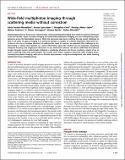Files in this item
Wide-field multiphoton imaging through scattering media without correction
Item metadata
| dc.contributor.author | Escobet-Montalbán, Adrià | |
| dc.contributor.author | Spesyvtsev, Roman | |
| dc.contributor.author | Chen, Mingzhou | |
| dc.contributor.author | Saber, Wardiya Afshar | |
| dc.contributor.author | Andrews, Melissa | |
| dc.contributor.author | Herrington, C. Simon | |
| dc.contributor.author | Mazilu, Michael | |
| dc.contributor.author | Dholakia, Kishan | |
| dc.date.accessioned | 2018-10-12T19:30:08Z | |
| dc.date.available | 2018-10-12T19:30:08Z | |
| dc.date.issued | 2018-10-12 | |
| dc.identifier | 252078679 | |
| dc.identifier | 52b172cc-2b1b-4921-9350-591f6863002d | |
| dc.identifier | 85054904640 | |
| dc.identifier | 000449221200055 | |
| dc.identifier.citation | Escobet-Montalbán , A , Spesyvtsev , R , Chen , M , Saber , W A , Andrews , M , Herrington , C S , Mazilu , M & Dholakia , K 2018 , ' Wide-field multiphoton imaging through scattering media without correction ' , Science Advances , vol. 4 , no. 10 , eaau1338 , pp. 1-9 . https://doi.org/10.1126/sciadv.aau1338 | en |
| dc.identifier.issn | 2375-2548 | |
| dc.identifier.other | ArXiv: http://arxiv.org/abs/1712.07415v1 | |
| dc.identifier.other | ORCID: /0000-0002-6190-5167/work/49308257 | |
| dc.identifier.uri | https://hdl.handle.net/10023/16210 | |
| dc.description | Funding: This work is supported by the UK Engineering and Physical Sciences Research Council for funding through grants EP/P030017/1 and EP/M000869/1, and has received funding from the European Union’s Horizon 2020 Programme through the project Advanced BiomEdical OPTICAL Imaging and Data Analysis (BE-OPTICAL) under grant agreement no. 675512, The Cunningham Trust and The RS MacDonald Charitable Trust. KD acknowledges the financial support of Elizabeth Killick and Susan Gurney. | en |
| dc.description.abstract | Optical approaches to fluorescent, spectroscopic, and morphological imaging have made exceptional advances in the last decade. Super-resolution imaging and wide-field multiphoton imaging are now underpinning major advances across the biomedical sciences. While the advances have been startling, the key unmet challenge to date in all forms of optical imaging is to penetrate deeper. A number of schemes implement aberration correction or the use of complex photonics to address this need. In contrast, we approach this challenge by implementing a scheme that requires no a priori information about the medium nor its properties. Exploiting temporal focusing and single-pixel detection in our innovative scheme, we obtain wide-field two-photon images through various turbid media including a scattering phantom and tissue reaching a depth of up to seven scattering mean free path lengths. Our results show that it competes favorably with standard point-scanning two-photon imaging, with up to a fivefold improvement in signal-to-background ratio while showing significantly lower photobleaching. | |
| dc.format.extent | 9 | |
| dc.format.extent | 1251291 | |
| dc.language.iso | eng | |
| dc.relation.ispartof | Science Advances | en |
| dc.subject | QC Physics | en |
| dc.subject | E-DAS | en |
| dc.subject | BDC | en |
| dc.subject | R2C | en |
| dc.subject.lcc | QC | en |
| dc.title | Wide-field multiphoton imaging through scattering media without correction | en |
| dc.type | Journal article | en |
| dc.contributor.sponsor | EPSRC | en |
| dc.contributor.sponsor | EPSRC | en |
| dc.contributor.sponsor | European Commission | en |
| dc.contributor.institution | University of St Andrews. School of Physics and Astronomy | en |
| dc.contributor.institution | University of St Andrews. School of Medicine | en |
| dc.contributor.institution | University of St Andrews. Biomedical Sciences Research Complex | en |
| dc.identifier.doi | https://doi.org/10.1126/sciadv.aau1338 | |
| dc.description.status | Peer reviewed | en |
| dc.identifier.grantnumber | EP/P030017/1 | en |
| dc.identifier.grantnumber | EP/M000869/1 | en |
| dc.identifier.grantnumber | 675512 | en |
This item appears in the following Collection(s)
Items in the St Andrews Research Repository are protected by copyright, with all rights reserved, unless otherwise indicated.

